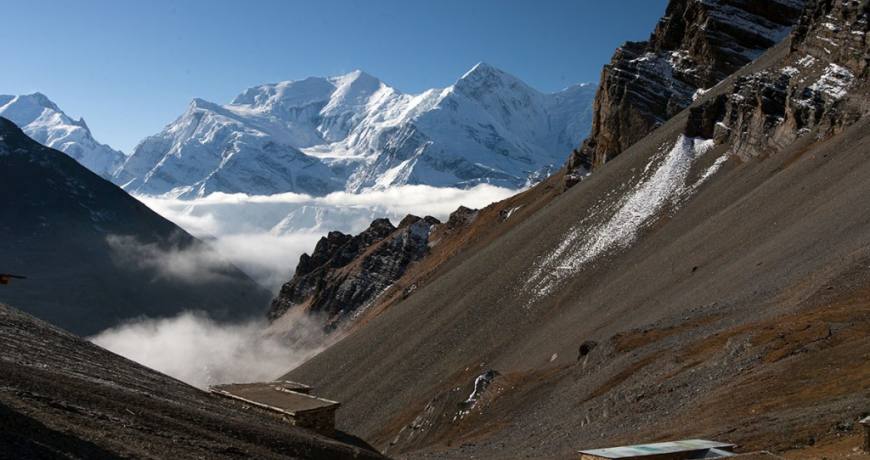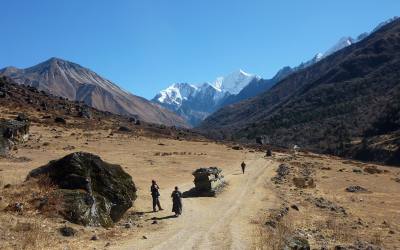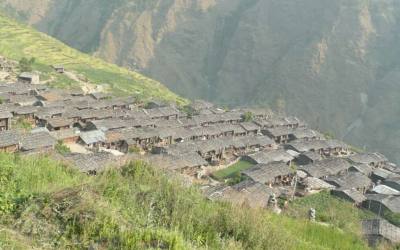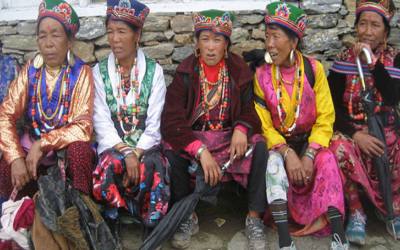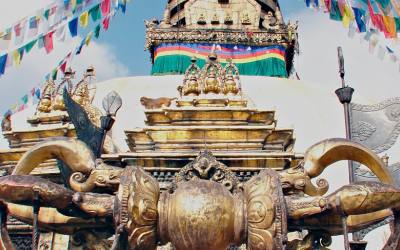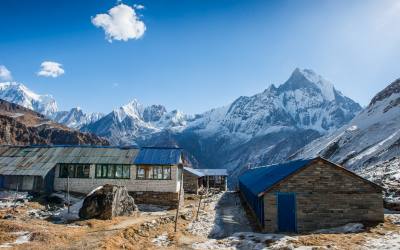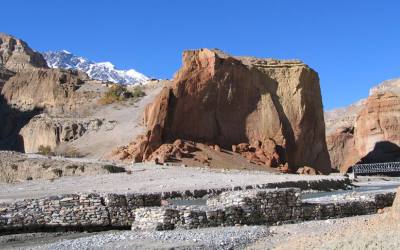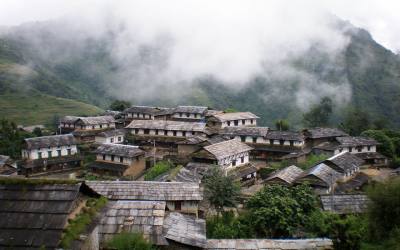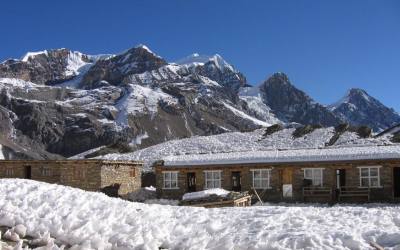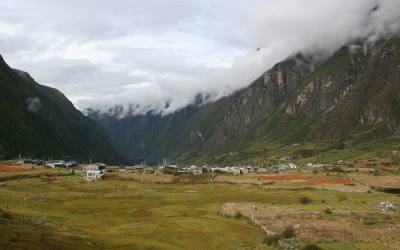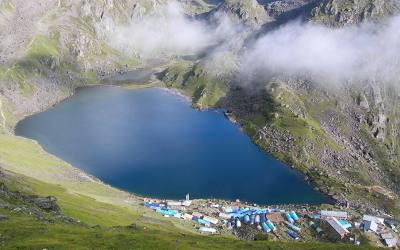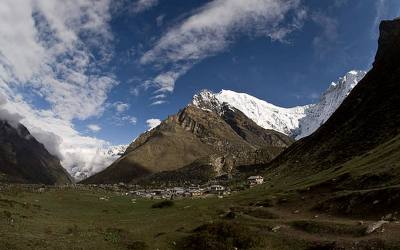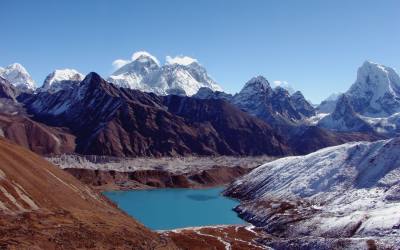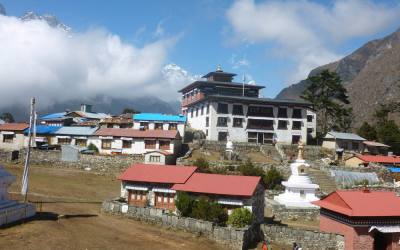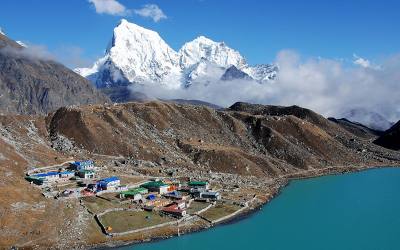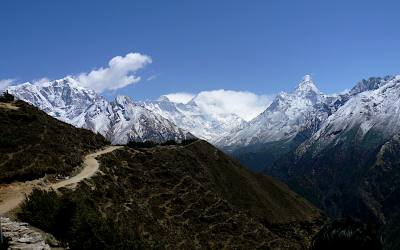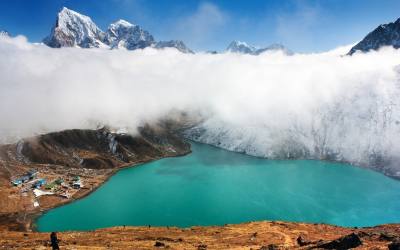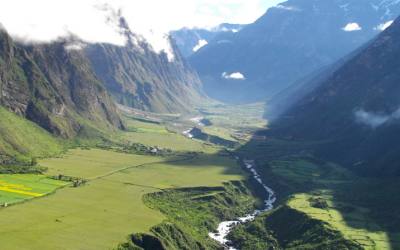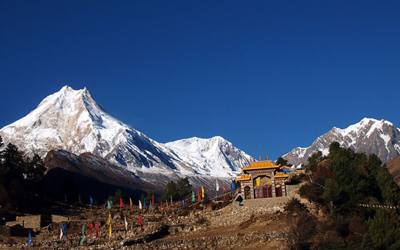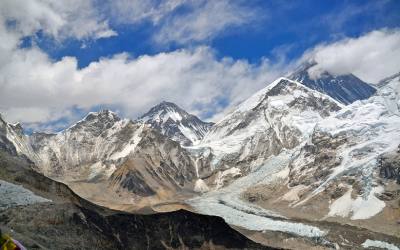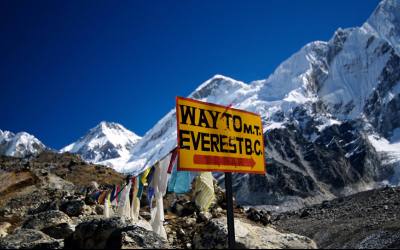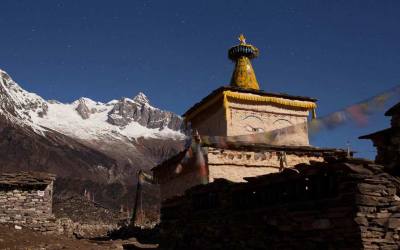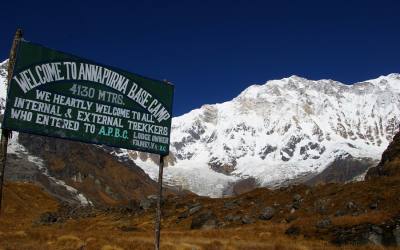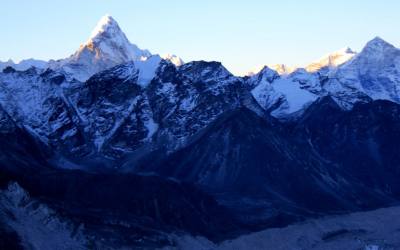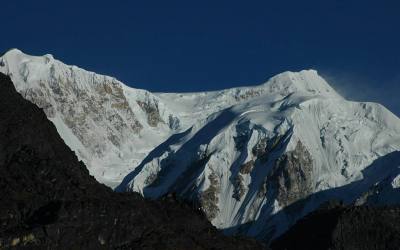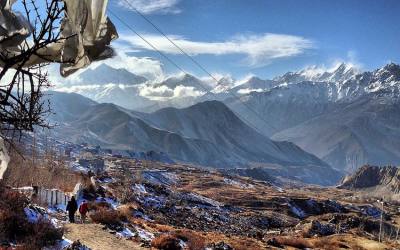Annapurna area is the most popular trekking region in Nepal, every year visited by 70 percent of trekkers, and for good reason. the deep valleys and high mountains encircling the giant Annapurna himal embrace a wide range of peoples and terrains, from subtropical jungle to a geographic extension of high, dry , Tibetan Plateau. The scenery is superb mix of lush vegetation, mountain peaks and an endlessly changing procession of people.
The course is called the Marshyandi trail. It goes upstream along the Marshyandi river. Trek through canyons and gorges and move on the north side of Himalayas pass Manang. Which was once kingdom.Cross Palace, people that live in the villages on this route are the Brahman, Cheetris, Newars, Tamangs, Gurungs and brought about by Hinduism and Tibetan Buddhism.you will also see the climatic and environmental distinctiveness of the both in the south and the north of the Himalayas.
Flora and Fauna
The range of geographical and climatic regions has led to a diverse variety of flora and fauna with in the Annapurna region. these parts of area are heavily cultivated and the landscape is terraced paddy fields for most of the year.the higher up in the hills the natural vegetation changes from the tropical species to more temperate stands of forest trees including oak, beech and rhododendron.
People and culture
The most prominent ethnic groups in the annapurna region are the Gurung, Braman, chetri, Thakali and the Manangba.
Trekking styles:
Most of the trekking routes in the Annapurna region are well serviced by teahouses for most of their length. This is particularly true for most popular treks-the Jomsom trek, the Annapurna circuit and Annapurna base camp treks.
Trekkers should be aware, however that there is always the risk of being stranded by bad weather or injury/sickness between teahouses, particularly in the more remote parts of the trek itineraries. a good example is on the Annapurna circuit where there is one very long day when the high pass of Thorong La has to be crossed. There is little or no shelter available for most of this day and some trekkers have been caught unprepared by bad weather and altitude problems.
The treks in less developed areas, particularly the Dhaulagiri circuit and the trek east of Lamjung, definitely require trekkers to be self sufficient in food and shelter.
When to visit?
As with most of the trekking areas in Nepal, the best time to visit are during spring and autumn. Spring is the time for rhododendrons while the clearest skies are found after the monsoon in October and November. At these times the weather is generally mild and there is little rainfall. Unlike other parts of Nepal, the monsoon, from June to September, is the ideal time to visit pats of the region that falls in the rain shadow. In particular, upper mustang is the perfect destination during the rainy season. The winter months provide good trekking conditions throughout the foothills but some of the higher passes will be closed due to snow.
The classic trek in the Annapurna region is the Annapurna circuit. The complete circuit has only been possible since mid 1980’s when the Manang area was officially opened up to non-Nepali visitors. For and all-round experience of the scenery and culture of Nepal this trek has a lot to offer. Starting in the lush Marsyandi valley, that separates the Annapurna range from that of Manaslu, the scenery is composed of lush cultivated fields with dense forests on either side. In the winter season, orange tree are laden with fruits and fragrant frangipani blossoms cast their scent along the trails. As you travel higher the valley becomes more rugged until the villages and forests finally give way to the arid hills of Manang. The Thorong La pass, at 5416 meters, marks the highpoint of the treks after which the trail joins the kali Gandaki river that flows through the deepest gorge on earth.
This is a challenging trek that is not without some risks. The crossing of Thorong La can be dangerous at times, especially during unexpected snowfall so potential trekkers must make sure that they are well prepared and equipped for all eventualities. The trek can be completed in a minimum of fifteen days, starting in Kathmandu and finishing in Pokhara. If a few extra days are allowed for it is then possible to enjoy several of the possible side trips and add immeasurably to the experience. And entry permit for the Annapurna conservation area project (ACAP) is needed for this trek.
Most trekkers start the trek by taking the bus from Kathmandu to Besishahar. These days the journey accomplished in around five or six hours which allows a few hours trekking on the first day. The trail from Besishahar follows the partly constructed road as far as the small market town of Kuldi. This road can be avoided by crossing the river below Besishahar and trekking along the east bank of the river rejoining the main trail at Bhul Bhule.
The first few days of the trek follow the Marshyangdi through scattered farming communities by a mixer predominantly composed of Gurungs but with a sizeable numbers of Brahmin communities. The crop range from rice and wheat at the lower elevations to corn, millet and barley as the altitude increases. Above the valley floor the hills are cloaked in forest with the occasional clearing indicating human settlements. Higher still, the snowy peak of the Annapurna and the Manaslu ranges dominate the skyline. A feature of this section of the trek is the number of high waterfalls that cascade down into the main river. The valley rises slowly slow altitude sickness is rarely a problem at this stage.
After a four days on the trail the river, which has been flowing from the north changes its course and flows from the west. At this point the landscape changes with steep rocky gorges on its side and large stands of pine making up the forest cover. By the time the district headquarters of Chame has been passed the hills are becoming more and more barren and the people predominantly Manangba. Look for a number of ancient temples, some of which represent the pre-Buddhist, Bon religion.
The tree line is reached a few hours before arriving at mustang where a compulsory rest day should be taken for acclimatization to the increasing altitude. There are a number of possible side trips from Manang that can be taken on the acclimatization day. Perhaps the most spectacular is to the west, across the river and up to the Gangapurna glacier with its deep blue lake formed by the melting glacial ice. The Himalayan rescue association clinic is located in Manang village and holds afternoon awareness lectures for trekkers warning of the dangers of AMS. These lectures are well worth attending.
From Manang, the trial passes through high alpine pastures until the small cluster of teahouses at Thorong Phedi id reached. An early morning start from here will allow you to reach Thorong La by mid morning and then start the long descent across the scree slopes to Muktinath before the afternoon cloud sweeps in. the whole section have no permanent settlements and shelter is hard to find. For safety, trekkers should never travel alone this section.
Muktinath, a famed pilgrimage site for both Buddhists and Hindus, is the first major settlement reached after the crossing of Thorong La. Be sure to visit the temples here and especially look for the eternal flame, fuelled by natural gas, which can be found in the small Buddhist temple below the main shrine.
From Muktinath the views of the west are now of the Dhaulagiri range while to the north can be seen the arid hills of upper mustang. The trial Leeds down through villages inhabited by people of Tibetan stock until it reaches the banks of the kali Gandaki River, the home of Thakali people. A further four days trekking down through this, the deepest valley on earth, brings you to the road head at Beni from where buses to Pokhara can be found. Settlements of particular interest below Muktinath are Jomsom with its airport, a possible exit point to Pokhara, Marpha with its fascinating medieval architecture designed to ward off the fierce winds that blow daily up the gorge and Tatopani with its hot springs.
There are a number of possible side trip that can be combined with the Annapurna circuit. Either from the Manang side or from below Jomsom it is possible to trek up to the high-altitude lake at Tilicho. You must allow at least four days for this trek and be fully self-sufficient. Also on the eastern side of the kali Gandaki there is a trial that leads to the original north Annapurna base camp that was used by the French expedition that first scaled the peak. On the western side of the valley treks to Hidden valley via Dhampus pass and to the Dhaulagiri icefall are also possible option. All of these site trips are suitable only for fit and experienced parties who are fully self-sufficient.
Day 01:Arrival & transfer to hotel in kathmandu
Day 02: Free day in kathmandu or self sightseeing around kathmandu valley.
Day 03: Kathmandu to Besisahar by local bus then by local jeep to Syanje
Day 04: Syanje to Dharapani(1943m) 6 hrs of trek
Day 05: Dharapani to Chame (2,710m/8,891ft): 5 - 6 hours
Day 06: Chame to Pisang(3292m) (3,300m/10824ft): 5 - 6 hours
Day 07: Pisang to Manang(3351m) 6 hrs of trek
Day 08: Manang- Rest day and Explore surroundings to ice lake or to Monastery
Day 09: Manang to yak Kharka (4,110m/13,484ft): 3 - 4 hours
Day 10: Yak Kharka to Throng Phedi high camp (4,600m/15,092ft): 3 - 4 hours
Day 11: Thorong phedi (Thorong La 5514m) to Muktinath 3802m. 7 hours of trek
Day 12: Muktinath to Marpha (2670m) 7 hrs of trek
Day 13: Marpha to Ghasa (2010m) 6-7 hrs of trek
Day 14: Ghasa to Tatopani (1190m) 6-7 hrs of trek
Day 15: Tatopani to Sikha village (2400m) 5-6 hrs of trek
Day 16: Tatopani to Ghorepani(2800m) 4 hrs of trek
Day 17: Ghorepani/ Poon hill to Hille, Nayapul to Pokhara. 7 hrs of trek and one hour of driving
Day 18: Free day in Pokhara or (self visiting around Pokhara valley )
Day 19: Return back to Kathmandu by tourist bus. The bus Journey will take 6 to7 hrs
Day 20: Free day in kathmandu or self sight seeing around the valley
Day 21: Tour ends ( Departure for onwards destination)
Day 01: Arrival & Transfer to Hotel in kathmandu
Upon arrival in Kathmandu. Our airport representative will be waiting outside the airport terminal a few metres from the exit door. Please check your name at play card. He will bring you to hotel in kathmandu. The drive from the airport to the hotel is around 20 minutes.
Hanumandhoka (Kathamdnu Durbar Square):
It is the historic seat of royalty. The Durbar Square, with its old temples and palaces, epitomizes the religious and cultural life of people. It is here that kings of Nepal are crowned and their coronations solemnized. Interesting things to see here are, Taleju temple built by king Mahendra Malla in 1954 AD, the temple of Kal Bhairab , the god of destruction, Nautale durbar, the statue of King Pratap Malla, the big drum and the Jaganath temple. It was listed in the UNESCO world heritage monument list in 1979.
On the right hand corner, a large wooden lattice screen hides an enormous gilded face of Sweta Bhairab. The screen is removed only during the Indra Jatra festival.. there are also the Numismatic museum and Tribhuban museum inside the Hanuman Dhoka palace building . Photography is prohibited inside the museums. Both the mseums remain closed on Tuesday and government holidays.
Day 02: Free day or self visiting around Kathmandu valley (option are)
Budhanilkantha:
About 8km north of Kathmandu at the base of Shivapuri hill is a remarkable huge statue of Lord Visnhu. Reclining on a bed of snakes.This is one of the masterpieces of stone sculptures of the Lichchhavi period. This fifth century statue is in the middle of a small pond and seems to float in water.
Swoyambhunath (Monkey Temple)
This is one of the world‘s most glorious Buddhist Chaityas. It is said to be 2,000 years old. Painted on the four sides of the spire’s base are the all seeing eyes of Lord Budhha. It is 3Km west of Kathmandu city and it situated on a hillock about 77 m commands an excellent view of the Valley. This stupa is the oldest of its kind in Nepal. It was listed in the UNSCO world Heritage Monument List in 1979.
Boudhanath stupa
Boudhanath Stupa (or Bodnath Stupa) is the largest stupa in Nepal and the holiest Tibetan Buddhist temple outside Tibet . It is the center of Tibetan culture in Kathmandu and rich in Buddhist symbolism. The stupa is located in the town of Boudha , on the eastern outskirts of Kathmandu .
History
Bodnath was probably built in the 14th century after the Mughal invasions; various interesting legends are told regarding the reasons for its construction. After the arrival of thousands of Tibetans following the 1959 Chinese invasion, the temple has become one of the most important centers of Tibetan Buddhism. Today it remains an important place of pilgrimage and meditation for Tibetan Buddhists and local Nepalis, as well as a popular tourist site.
Pashupatinath Temple( Hindu temple)
Situated 5km east of kathamandu, the temple of Lord Shiva, Pashupatinath, with two tired golden roof and silver door is considered one of the holiest for Hindus. Although only Hindus are allowed inside the temple, visitors can clearly see the temple and the activites performed in the Temple premises from the eastern bank of the Bagmati river. The Temple was listed in the UNESCO world heritage Monument List in 1979
Day 03: Kathmandu to Besisahar by local bus then by local jeep to syange village (1250m) the drive will take 10 hrs.
On the way you can see villages, the river terrace of the Marshandi river and farm fields.
Day 04: Syange to Dharapani(1943m)
Move on along the river making many ascents and descents the river becomes gradually narrower and trek faces on both sides becomes steeper. Crossing the suspension bridge and climbing the terrace , you will reach lower village of Dharapani. The people here called Bhote Gurung. They are Tibetan Buddhist. About 10 minutes up-hill walk from Dharapani there is Thorong La village, where a Buddhist Monastery was established 104 years ago.
Day 05: Dharapani to Chame(2713m)
Entering a Dence forest, cross over the bridge over tributaries and shortly afterwards near the foot of the water fall , climb steep stone steps . just beyond these up to Chame in about three and haif hour. Good views of Annapurna. The lower part of the Chame is the administrative centre of Manang district. The upper part mainly inhabited by Tibetans. There is a hot spring just below this upper section.
Day 06: Chame to Pisang(3292m)
Leave the upper village of Chame on the left flank follow the path in the pine forest and climb along the river repeating ascents and descents till Bharatang. From here crossing suspension bridge you will reach Manang valley. A speculates Rockwell is in view for much of this climb. It will take about 3hrs to reach pisang.
Day 07: Pisang to Manang(3351m)
During today’s journey, you can enjoy a wonderful view of Annapurna Himal. It is the viewing day on the Marshyangdi trail till Hongde. Which has an airfield. The road leading to Manang becomes wider. Houses are built crowded together and a white Gompa stands above them all, contrasting with the dark walls of the houses. You will see Manang on the terrace in front of you . from here enjoy the view of Gangapurna to the right of the glacier and Annapurna to left.
Day 08: Manang- Rest day and explore to ice lake or to Buddhist Monastery
This is very important day to use acclimatization before you got to high altitude. There are plenty of good day hikes in this area.
It is a proper Bhot valley. It lies in the confluence of river Marsyangdi and Thorang khola. On both side of valley-north and south –high Himalayan ranges are stretched continuosly from east to west of Manang Bhot. It falls in the rain shadow area of Annapurna range, where less than 300mm of annual rainfall occurs, most of which falls in the form of snow. This bhot balley is regarded as the coldest snow desert of Nepal.
Day 09: Manang to Yak Kharka(4200m)
Walking through the dark colored houses of Manang and following the path of stone walls and sandy path. You will arrive to Yak Kharka or Koche village. Koche is famous for grazing animals. In the pasture land grasses and varieties of seasonal flowers are found. It has glaciers and other water resources. It makes this place very attractive.
Day 10: Yak Kharka to Throng Phedi high camp (4780m)
Trail continues towards to remote throng phedi , you will not see anymore trees around here. Latter gradually climb uphill towards to base camp. Thorung phedi is a small hamlet situated near the Marshandi river. It is situated at an altitude of 4450m. just below the settlement, there is a big pasture land. All the other surroundings area are naked and snowy mountains.
Day 11: Thorong phedi (Thorong La 5514m) to Muktinath 3802m.
Today is most difficult day and highlight section of this course. It is going to be long journey and it is wise to leave early in the morning . trail continues uphill all the way to Thorong pass where you can see stone hillock with flapping prayer flag . as soon as crossing throng La trail descending all the way to Muktinath. The green, sacred land for Hindus and Buddhist.
Day 12: Muktinath to Marpha (2667m.)
You now begin the descent down the dramatic Kali Gandaki Gorge, initially through arid country in the same geographical and climatic zone as Tibet. After passing through Jharkot and Khingar villages with typical Tibetan architecture, you follow the valley floor most of the way to Jomsom which is sprawled along both banks of the Kali Gandaki .From here there are nice views of the Nilgiri peaks. You continue walking down to Marpha, a delightful Thakali village, complete with a drainage system beneath the flagstone streets. Its narrow alleys and passageways provide welcome shelter from the strong winds of the Kali Gandaki Gorge. Marpha is particularly well known for its apples, apple cider and apple, apricot and peach rakshi.
Day 13: Marpha to Ghasa (2013m.)
Your trail descends steeply through forests to Ghasa, the last Thakali village and the southern-most limit of Tibetan Buddhism. The beginning part of the trail is stretched to an almost flat level up to Kalopani and then your trail begins descending steeply to Ghasa. The first part of the trek passes through the windy area covered with pine forests, rhododendron forests and birches .The surrounding area of Ghasa is a famous destination for bird watching and wild Marijuana. Here you are quite amazed at the panoramic view of Mount Nilgiri North (7061m.), Nilgiri Central (6940m.), Nilgiri South (6839m.), Annapurna I (8091m.), Dhaulagiri I (8167m.) and Tukuche peak (6920m.)
Day 14: Ghasa to Tatopani (1190m)
The trail descends steeply to Rukse Chhahara (Rukse Waterfalls) which is amazing to look at. Here is situated the deepest gorge of the world between two mountains Annapurna I (8091m.) and Dhaulagiri I (8167m.) which face each other near Rukse Waterfalls. Now, the trail ascends slightly to Tatopani through different human settlements. You can enjoy the hot spring at Tatopani as the word Tatopani is termed after the natural hot spring situated at the bank of the Kali Gandaki River.. It is believed that one who takes a bath in this hot spring gets rid of skin diseases along with providing physical and mental refreshment .After several days of trekking; taking a bath in the hot spring is a wonderful way to relax
Day15: Tatopani to Sikhha village
Your trail passes through flat level land for some distance and then begins ascending steeply for at least one hour. The path leads you through different villages inhabited by the people of different castes and variety of agricultural land. The majority of the people here serve in the Gorkha or Indian Regiments. While trekking you cross through the Kali Gandaki River with panormic views of Dhaulagiri and Annapurna ranges.
Day 16: Sikha village to Ghorepani(2850m)
The trail ascends gently all the way to Ghorepani passing through small villages like Phalate, Chitre and so on. While trekking you pass through rhododendron forests and come across wild life such as monkeys and birds of various species. You are also greeted by more panoramic views of many different mountains. From Ghorepani (Watering to Horse) there is a small pass and the village of Deurali. Although there is time enough to continue, it is better to stay here overnight so that you can make the morning trip to Poon Hill (3180m.) for an outstanding panoramic view of Dhaulagiri I,II,III, IV, Tukuche peak, Dhampus peak, Nilgiri ranges,Annapurna I, Bahra Sikhar (Twelve peaks or renowned as French Fang),Annapurna South, Himchuli, Fishtail and Mardi Himal. The view you can see from here is probably the best view in the world. Because of this, Poon Hill is often crowded by different visitors wanting to enjoy the sunrise and sunset views over the snow-capped mountains.
Day 17: Ghorepani/ Poon hill to Hille then to Pokhara by private transport
Early in the morning climb uphill for one hour to reach Poonhill (3210m) for sunrise tour and mountain views. In a clear day you can see Manasulu Range, Annapurna Range, Dhaulagiri Range and Nilgiri. It is one of the high light of Annapurna Region .after breakfast trail continues down hill through rhododendron forest till Hille. From here,
Walking through terrace and rice paddies for 2 hours to reach to Nyapul then by private transport to Pokhara
Day 18: Free day or self Sightseeing around Pokhara ( option are)
Pokhara is a place of remarkable natural beauty. Situated at an altitude of 827m from sea level and 200km west of the Kathmandu Valley, Pokhara city is the most popular tourist destination in Nepal. This enchanting city, with a population of around 95,000, has several beautiful lakes and offers stunning panaromic views of the Himalayan peaks. The serenity of lakes and the magnificence of the Himalayas rising behind them create an ambience of peace and magic. Pokhara city is also the starting point for many popular treks in Nepal.
Pokhara is part of a once vibrant trade route extending between India and Tibet. To this day, mule trains can be seen camped on the outskirts of the town, bringing goods to trade from remote regions of the Himalaya. This is the land of Magars and Gurungs, hardworking farmers and valorous warriors who have earned worldwide fame as Gurkha soldiers. The Thakalis, another important ethnic group here, are known for their entrepreneurship.
The climate of Pokhara is slightly warmer than Kathmandu with daytime temperatures of around 15 degrees Celsius in the winter and 35 degrees in the summer.
Sarangkot
The view of the Annapurna Himalaya from Sarangkot is almost a religious experience. From here, you can see a panoramic sweep of Himalayan peaks, from Dhaulagiri (8167m) in the west to the perfect pyramid that is Machhapuchhare (6997m) and the rounded peak of Annapurna II (7937m) in the east. Most people come here at dawn or dusk, when the sun picks out the peaks in brilliant colours.
Fewa lake
Fewa Lake, the second largest lake in the Kingdom, is the center of attraction in Pokhara. It is the largest and most enchanting of the three lakes that add to the resplendence of Pokhara.
Mahendra cave
Another of nature’s wonders in Pokhara is the Mahendra Gupha. This large limestone cave is locally known as the House of Bats, an apt name for it. A two-hour walk to the north of Pokhara, it is best to bring your own torch to see the stalactites and stalagmites, as well as the local winged residents.
Seti River
Another of Pokhara’s natural wonders that unfailingly interests visitors is the Seti river. Flowing right through the city, this river runs completely underground at places. Amazingly, at certain points the river appears hardly two meters wide. But its depth is over 20 meters! Mahendra Pul, a small bridge near the old Mission Hospital, provides a perfect view of the rivers’s dreadful rush and the deep gorge made by its powerful flow.
Barahi Temple
The Barahi temple is the most important monument in Pokhara. Built almost in the center of Phewa Lake, this two-storied pagoda is dedicated to the boar manifestation of Ajima, the protectress deity representing the female force Shakti. Devotees can be seen, especially on Saturdays, carrying male animals and fowl across the lake to be sacrificed to the deity.
Museum
The Pokhara Museum, located between the bus stop and Mahendra Pul, reflects the ethnic mosaic of western Nepal. The lifestyles and history of ethnic groups such as the Gurung, Thakali and the Tharu are attractively displayed through models, photographs and artifacts. One major attraction is a display highlighting the newly-discovered remains of an 8000-year-old settlement in Mustang.
Open daily, except Tuesdays and holidays, from 10 am to 5 pm
Day 19: Return back to Kathmandu by tourist bus. The bus journey will take 6 to 7 hrs or by air to kathmandu. it takes about 40 minute by flight.
Day20: Free day in kathmandu or self sight seeing around the valley.
Bhaktapur
Situated at an altitude of 1,401m, Bhaktapur covers an area of four square miles. Bhaktapur or the city of Devotees still retains a medieval charm and visitors to this ancient town are treated to myriad wonders of cultural and artistic achievements. The past glory of the Malla rulers continues to be reflected at the Durbar Square. Pottery and weaving are its traditional industries. Bhaktapur is famous for woodcarving and the Bhadgaolen topi or cap. The city lies about 14 km east of Kathmandu and can be reached by public transport and by trolley buses.
Bhaktapur durbar Squares:
The Golden Gate is the entrance to the main courtyard of the Palace of 55 Windows.Built by King Ranjit Malla. The gate is one of the most beautiful and richly carved specimens of its kind in the entire world. This gate is embellished with deities and monsters with marvelous intricacy. The palace of 55 windows was built in 1700 AD. Among the brick walls in their gracious setting and sculptural design, is a balcony of 55 windows. This balcony is a masterpiece of wood carving. The stone temple of Batsala Devi which is also located in the Durbar Square is full of intricate carvings. This temple also sets a beautiful example of Shikhara style architecture in Nepal. There is a bronze bell on the terrace of the temple which is also known as the Bell of Barking Dogs.
This colossal bell, placed in 1737 AD, was rung to signal curfew those days.
The main square of the city contains innumerable temples and other architectural showpieces like the Lion Gate, the statue of King Bhupatindra Malla, the Picture Galley, the Batsal Temple, etc. A magnificent statue of King Bhupatindra Malla in the act of worship is placed on the column facing the palace. It was listed in the UNESCO World Heritage Monument list in 1979.
Changu Narayan:
Situated at the end of a long ridge which runs well into the Valley, It is said to have been built by king Hari Dutta in 323 AD said to be the oldest temple in the valley. It was listed in the UNESCO world Heritage Mountain list in 1979
Patan
The ancient city of Patan, lying 5 km southwest of kathmandu, is known as the city of fine arts, The city is full of Hindu temples and Buddhist monuments. The diversity of the medieval culture that allowed both Hinduism and Buddhism to flourish has left a rich legacy of impressive sightseeing in this city for today’s visitors.
Patan Durbar Square: Situated in the heart of the city, constitutes the focus of visitor’s attraction. The square is full of ancient palaces, Temple and shrines, noted for their exquisite carvings. The Patan durbar Square consist of three main chowks or countryards, the Central Mul Chowk, Sundari Chowk and Keshar narayan Chowk, The Sundari Chowk holds in its center a masterpiece of stone architecture. The Royal Bath called Tushahity. It was listed in the UNESCO world Heritage Monument list in 1979.
Krishna Mandir:
Built in 1637 AD, the temple of Lord Krishaa holds a commanding position in the palace complex of Patan. It is supposed to be the first specimen of Shikhara style architecture in Nepal. It is the only temple in Nepal having 21 spires and is completely 21 spires and is completely mad of stone.
Day 21 : Tour Ends ( Departure for onwards destination)
Price Per Person US$ 775.00 (Price are based on standard class hotel)
Price for meals and drinks during the trek Allow US$ 22-25 per person per day for trekking (off-course you are going to pay every day directly by yourself to the tea houses during the trek.it is just a guideline)
Single supplement US$ 150.00 per person ( you will get single room in kathmandu and during the trek. you can also book your trekking tour as a single person with us. in this case we will charge little higher)
Additional night in kathmandu will cost US$ 35.00 for Double room with Bed and Breakfast and US$ 30.00 for single room.
Additional night in Pokhara will cost US$ 35.00 for Double and US$ 30.00 for single room with bed and breakfast.
Trekking prices with out hotel in kathmandu and in Pokhara will cost US$ 700.00 per person.
Off-course it is always possible to upgrade the hotel in kathmandu according to your budget and interest. But it will cost you extra and you need to pay the differences.
Hotel we use in this tour (Standard class hotel)
Kathmandu Prince Hotel (standard class hotel)
Thamel, Chhetrapati, kathmandu, Nepal Tel : 4255961, 4255282, Fax : 977-1-4255282
E-Mail : [email protected] Website : www.kathmanduprincehotel.com
Or
Potala Guest House (Standard class hotel)
Thamel, chetrapati, Kathmandu Tel : 4226566, 4220467
Email: [email protected] Website : www.potalaguesthouse.com
Or
Hotel Marsyandi Mandala (Standard class hotel)
Thamel, Chhetrapati, Dhobichour, Kathmandu,
Email: [email protected]
http://www.marsyangdimandala.com
Hotel Kantipur (2 Star)
VIP Area Lake -Side Pokhara, Nepal
E-mail: [email protected]
http://hotelkantipur.com
or
Hotel we use in Pokhara
Pokhara village Resort (Standard class)
Email: [email protected]
[email protected] www.pokharavillage.com
Delux class hotel
Hotel Manasulu (3star)
Address: 230, Hotel Marg, Lazimpat, Kathmandu, Nepal
Website: www.hotelmanaslu.com
Grand Hotel Kathmandu (4star)
Email: [email protected]
http://www.grandhotelnepal.com
Hotel Manang Pvt. Ltd (3star)
Thamel, Kathmandu, Nepal
Tel: +977-1-4700389, 4700993
Email: [email protected],
http://www.hotelmanang.com
Hotel Yellow pagoda (4 star)
Contact Information
Kantipath, Kathmandu, Nepal
+977 1 4227345, 4220041
[email protected]
www.yellowpagoda.com
Radission hotel kathmandu (5star)
https://www.radisson.com/kathmandu-hotel-np/nepkathm
Hotel Yak & Yeti (5star)
GPO Box no. 1016
Durbar Marg, Kathmandu, Nepal
Tel : +977-1-4248999, 4240520
Fax: +977-1-4227781/ 4227782
http://www.yakandyeti.com/
Hotel Barahi (Delux hotel 3 star)
Lakeside,Pokhara-6,
http://www.barahi.com
Hotel Temple tree resort and spa (Delux hotel in Pokhara) 4 star
Gaurighat, Lakeside 6, Nepal
[email protected]
http://templetreenepal.com
Fishtail Lodge Pokhara (5star)
P.O. Box 10
Lakeside, Pokhara, Nepal
Tel: +977 61 465071/460248/460258
Fax: +977 61 465072
E-mail:
[email protected] / [email protected]
http://fishtail-lodge.com/fishtail/
shangri-La Kathmandu & Pokhara (5star)
Address: Lazimpat, Kathmandu Nepal
Email: [email protected]
Phone: +977-1-4412999 I 4419743
Shangri-La Pokhara:
Address: Gharipatan, Pokhara, Nepal
http://hotelshangrila.com/
Note: As per our company rule to confirm your booking with us we do need photo copy of your passport, one passport size photo graph, international flight details (Date of arrival , date of departure ,flight number ) and 15% of total amount as a down payment. Rest remaining other amount you can pay to us upon your arrival in kathmandu. Once you agreed to booking with us then we can provide you our bank details to make wire transfer or you can also pay by major credit cards such as visa, Master or by American express. in this case you need to send us copy of your credit cards. But it will cost you 5% extra because it is the rule of our local bank.
Note: If some one who is willing to book their trekking tour as a private then the tour will departure everyday.
What’s Included
- Airport Pickup and Drop by private transport (only for International flight)
- Kathmandu to Besisahar by local bus then by local jeep to Syange. (Note: if you wish to hire private land crusher with driver then it will cost US$ 175.00 for one way. The land crusher will have 6 seats)
- Pokhara to Kathmandu by Tourist bus.
- Nayapul (Trekking ending point) to Pokhara by private transport
- 4 nights hotel in Kathmandu with Bed and Breakfast (Centrally located, Room with attach bathroom with hot and cold shower)
- 2 nights hotel in Pokhara with Bed and Breakfast (Centrally located, Room with attach bathroom and hot and cold shower)
- 14 nights 15 days trekking in lodges (lodges are simple but clean enough and has a hot and cold shower.But we will try to provide you best accomodation)
- Annapurna National Park Permit and Tims card (Trekking information management system) we need two photo each for permit
- One experience Trekking guide (trained by Ministry of tourism), one Trekking porter for every 2 client(our trekking porter will carry maximum 24 k.g.), price will include their meals, accommodation, transportation, equipments and insurance.
- Trekking Maps for Annapurna Region
- First aid kid box
- Sleeping bag for trekking
- Light cramspoons for trekking ( late november, Dec, Jan, Feb and early March)
- All the govt tax
What’s not Included
- Personal bar bill, travel insurance/International airfare/Domestic airfare.
- Items of personal expenses such as alcoholic drinks, cold drinks, laundry, tips etc.
- Nepal entry visa fee US$ 40 (duration 30 days from date of issue)- Available at Royal Nepalese Embassies and Royal Nepalese Consulates abroad or on arrival at Tribhuvan International Airport in Kathmandu.
- Sight seeing tour and All the entrance fees of temple in Kathmandu and Pokhara Valley
- All the meals during the trek ,Breakfast, Lunch and Dinner (Allow US$ 22 per person per day for trekking)
- Tips for trekking guide and porter
- Hot shower during the trek (some place they charge US$1 per shower)
